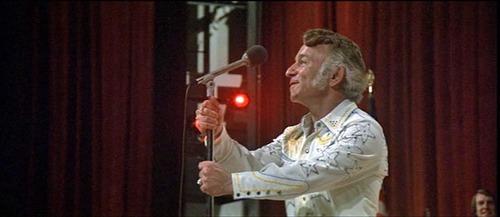View image Alejandro Polanco plays… Alejandro.
Within the first 30 seconds or so of Ramin Bahrani’s “Chop Shop,” you know you’re in good hands. I’ve written quite a bit about how much I loved Bahrani’s debut feature, “Man Push Cart,” from its opening shot to its final ingenious moment, and “Chop Shop” is a piece of filmmaking that is every bit as observant and assured. So, that first shot: A cluster of day workers stand in wait. This could be anywhere — California, Texas, Mexico, South America — but the first thing you sense is that it’s not: it’s this particular place, even if we don’t know the name of it yet. The camera (hand-held, but not shakycam style) pans to the left as a truck pulls up. A guy gets out and picks two men for the job, telling a persistent kid, “I don’t need you today” — and the accent is unmistakably NY. As the pickup pulls out, the kid hops into the back.
Simple enough, but in these few seconds the movie establishes a setting, a milieu, some characters and the beginnings of a story with an ease and grace that you don’t often see in the work of filmmakers who are much more established. What’s more, the film develops a sense of place, and the people who inhabit that place, that few movies ever succeed in capturing. This guy knows how to make movies.
I admit I went in wanting to like “Chop Shop.” I’d been wowed by “Man Push Cart,” and I met Bahrani and that film’s star, Ahmad Razvi, at Roger Ebert’s Overlooked Film Festival a couple years ago, and I liked them and their work so much I wanted them to succeed. But by the end of “Chop Shop” I was walking down Bloor Street about 18 inches above the sidewalk, just from seeing a film that skillfully avoided so many pitfalls and cliches, and that felt so fresh, so alive, and just so right down to its last detail. (And, once again, the moment at which the movie chooses to end is both unexpected and unexpectedly satisfying. Seconds before it happens, you just feel it’s so right it’s inevitable.)
Here’s what I knew about “Chop Shop” going in: It was directed by Ramin Bahrani and I was pretty sure it had a kid in it. That’s all. Except I knew it had been shown at Cannes. I wish you’d see the film the same way (trust me), but I want to tell you as little as possible while still conveying my enthusiasm.
View image Alejandro P., director Rahmin Bahrani, and DP Michael Simmondson the set in the setting of “Chop Shop.”
As usual, I’ll explain next to nothing of the story, except to say that it concerns a 12-year-old boy named Alejandro (Alejandro Polanco), who works any number of odd jobs (subway candy vendor, bootleg DVD salesman, chop shop assistant), mostly in and around the “Iron Triangle,” a neighborhood of body shops and junkyards in the shadow of Shea Stadium in Queens.
But here’s the thing: Too many of these “slice-of-life” movies feel like they’re made by tourists. They shoehorn a fairly generic story and characters into a “colorful” setting in hopes of getting a distribution deal at Sundance. In “Chop Shop,” the story and characters seem like details that the filmmaker has noticed within the hustle and bustle of this patch of city real estate — as if they were here all along, and it just took someone with a sharp eye and an attuned ear to pick them out and give them shape. The texture is organic and alive; the story is an accumulation of incidents and experiences.
Listen to the hum of an oscillating fan in a tiny plywood room; the irregular tapping sounds (rain on the roof, or expanding/contracting pipes, or an overworked mini-fridge?) that turn out to be coming from a bag of microwave popcorn; the rising and falling roar of an unseen ballgame echoing off the honeycomb of metal garage doors and cement walls. Notice the mud puddles in the potholed streets; the pit bulls and the pigeons; the meats sizzling on a grill at a block party; the elevated trains passing over and through on their way to other neighborhoods, other people, other “stories” (the way they’re photographed they are both part of the teeming cityscape and a reminder of a whole stratum of life going on above the low-lying realm where these characters scrape together a living, and a life).
View image Isamar Gopnzales and Alejandro Polanco, as sister and brother Isamar and Alejandro.
I don’t want to use one American indie to bash another, but… looks like I’m going to. Consider “Quinceañera,” a Sundance prize-winner that felt like a guided-tourist movie to me. In my review, I wrote:
If there was ever a movie that seemed precision-tailored for a Park City reception, this is it — the quintessential example of the festival’s favored brand of hand-crafted, slice-of-life, youth-oriented filmmaking that expresses affection for a nicely captured American subculture. In other words, it’s a Sundance specialty, right from the box.
This is a shopping-list movie: A double coming-of-age story spiced with local color; a bittersweet portrait of a Los Angeles neighborhood in transition; a warm and soapy celebration of a Mexican-American community. “Quinceañera” is also a thoroughly predictable melodrama that’s both kitchen-sink and “After-School Special.” You can see every plot development coming from miles away, much more clearly than you can see downtown L.A. from Echo Park most days. The story is so generic it seems put together from pre-fab modular elements…
The life of a movie is all in the details, the atmosphere, and the contrast between “Quinceañera” and “Chop Shop” could not be more vital or revealing.
Ahmad Razvi, the star of “Man Push Cart,” has a supporting role here as a local shop proprietor, but remains a star. The camera loves this guy, and he holds it with the magnetism of Harvey Keitel in early Scorsese movies. In fact, if Bahrani’s guiding influences in “Man Push Cart” were the likes of Bresson and Ozu, he seems to have been inspired by Scorsese and Altman this time, in making a movie that recalls “Pixote” and, of course, Italian Neorealist classics like “Bicycle Thieves” and “Paisan,” but without the slightest hint of sentimentality. I’m told he starts shooting his next movie in two weeks. My movie-lovin’ heartbeat quickens at the news….
December 14, 2012


